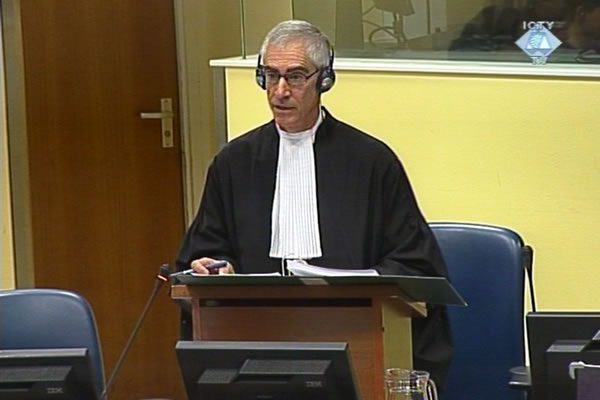Home
PROSECUTION WANTS TO CALL 19 ADDITIONAL WITNESSES IN KARADZIC CASE
The prosecution has sought permission to rebut Karadzic’s defense case through the testimony of 14 new witnesses, and to re-open its case to call five witnesses about the mass grave in Tomasica near Prijedor, discovered last year
 Alan Tieger, prosecutor at the Radovan Karadzic's trial
Alan Tieger, prosecutor at the Radovan Karadzic's trial As indicated earlier, the prosecution today filed two motions to reopen the prosecution case and rebut Radovan Karadzic’s defense case. The first motion pertains to the evidence to be called on the mass grave Tomasica near Prijedor. The mass grave was discovered after the prosecution rested its case. The second motion is a formality, as the prosecution is allowed to rebut the defense case. Karadzic then has the right to call his evidence in rejoinder.
The motion to call the evidence on Tomasica notes that the mass grave there was discovered in September 2013. The exhumation began right away, but the forensic analysis is still ongoing. The pathologists’ and archeologists’ reports will be completed by the beginning of April 2014; the remains should be identified by that time. The prosecution asked the judges to allow it to call three witnesses now: Amor Masovic from the BH Institute for Missing Persons, Ian Hanson from the International Commission on Missing Persons, and a protected witness. The witnesses’ written statements would be tendered into evidence, as indicated in the motion, and the testimonies could be completed in one day. As soon as the exhumation reports are ready, Ian Hanson will return to the witness stand, and the prosecution will call two other expert witnesses: forensic expert Thomas Parsons and forensic pathologist John Clark. Alternatively, the prosecution wants to call all its new evidence in one go, in April 2014, when the reports are finished.
As the prosecution explained, as early as in 2001 there were indications that there was a mass grave in the Tomasica mine, but the site remained unexplored until September 2013: the company running the mine deposited slag, earth and rocks on the spot. When the bodies were finally discovered, they were buried nine meters deep.
For the prosecution, the evidence from Tomasica is important because it can be used to prove that the Serb authorities were involved in the planning of the crimes, contrary to the defense's claims that the crimes were ‘random and rare’ acts of rogue individuals. The mass grave was created in the course of the operation in which non-Serbs were expelled from Prijedor, before the three biggest prison camps in that municipality were closed down. The bodies of the victims killed in late July 1992 in three separate incidents were recovered from the Tomasica mass grave: the Room 3 massacre in Keraterm, the Hrastova Glavica incident where prisoners from Omarska and Keraterm were killed, and the attack on the Brda area. The mass grave is too big for the number of victims exhumed from it to date, which indicates that the plan had been to bury more dead bodies in there. According to the prosecution, the dimensions and the fact that the victims had been brought there from different locations are indicative of the scope of the crimes, and this in turn shows that the officialdom headed by President Karadzic must have been involved.
As for the rebuttal of Karadzic’s evidence, the prosecution intends to tender into evidence the testimony of 10 witnesses of the events in the Bijeljina, Bratunac, Foca, Kljuc and Prijedor municipalities. Famous photographer Ron Haviv is one of the witnesses expected to give evidence about the situation in Bijeljina. The evidence of four other witnesses pertains to the events in Sarajevo and Srebrenica. Explaining the need to rebut Karadzic’s evidence, the prosecution noted that Karadzic’s approach to the defense case was ‘inconsistent, illogical and chaotic’. Karadzic’s defense was thus ‘difficult to predict’ and this calls for rebuttal evidence.
Linked Reports
- Case : Karadzic
- 2014-03-03 PROSECUTION WANTS TO FILE LONGER FINAL BRIEF BY 17 SEPTEMBER 2014
- 2014-02-27 ‘GENTLEMEN’S AGREEMENT’ MAY HELP KARADZIC
- 2014-02-27 KARADZIC WANTS ONE YEAR TO PREPARE HIS FINAL BRIEF
- 2014-03-14 AMERICA ACQUITTED OF KARADZIC’S ACCUSATIONS
- 2014-03-19 KARADZIC AGAINST TOMASICA EVIDENCE
- 2014-03-20 TOMASICA EVIDENCE ‘NOT IN THE INTEREST OF JUSTICE’
